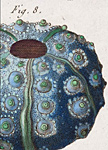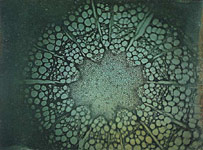Fractals
004b fractals -Leonardo de Vinci's 'Flower of Life'
discoveringdavinci.com:Leonardo’s 'Flower of Life' – c. 1478-1519. Codex Atlanticus Fol 307v
"A 'flower of life' is a geometrical figure that is made by creating 7 or more superimposed and evenly-spaced circles. The center of each circle is on the circumference of up to six neighboring circles of the same diameter. It’s thought, by some, to be a representation of the “Tree of life” and a symbol of “sacred geometry” that exemplifies a mathematical link to the divine."
via: v-o-g-u-e-and-v-o-d-k-a.tumblr.com
A picture of one of Leonardo da Vinci's drawings of the ornamental structure named today 'Flower of Life'.
Date between 1478 and 1519, source: Codex Atlanticus, fol. 307v
©: PD = Public Domain; more examples
tags: #Leonardo da Vinci, #flower of life, #fractals
004 fractals -Sea Urchin
 A fractal is a never ending pattern. Fractals are infinitely complex patterns that are self-similar accross different scales. (www.fractalfoundation.org)
A fractal is a never ending pattern. Fractals are infinitely complex patterns that are self-similar accross different scales. (www.fractalfoundation.org)Lamarck - 'Sea Urchin' (detail) Jean Baptiste (Pierre Antoine) de Monet, Chevalier de Lamarck [1744-1829] Sea urchins are sea creatures that live in oceans all over the world. Similar to sea stars, sea urchins have a water vascular system. Their spherical shape is typically small, ranging from about 3 cm to 10 cm in diameter, and their bodies are covered with a spiny shell. The skeleton of a sea urchin is also known as the test. The shells within the test of these creatures are made up of packed, fitted plates which protect them from being damaged. The spines, outlining their shell, are movable and help to camouflage or protect itself from predators. Sea urchins can vary greatly in colour. On the bottom side of a sea urchin there are five teeth that these organisms use to ingest algae and break down other foods they consume to survive.
©: public domain
tags: #Fractals, #Sea Urchin
ref. # 004a fractals -Andreas Ritter von Ettingshausen (1796-1878)
 Section of Clematis, 4 March 1840
Section of Clematis, 4 March 1840whole-plate daguerreotype
annotated ´Etamatic Querschnitt/14 Mai (lin...) vergrössern / Mit dem dag. Hydrogen Kaltlicht [...] / in fünf Minuten / Wein 4. März 1840 A.v. Ettingshausen
©: www.christies.com
tags: #Andreas Ritter von Ettingshausen, daguerreotype, fractals

